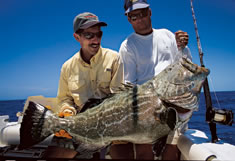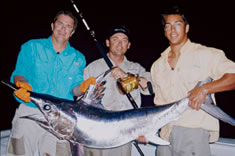Enjoy the benefits of super braid and monofilament with a top-shot line system.
|
|
Experienced anglers rely on a number of methods to catch big fish. One fundamental rule is to use a reel with enough line capacity for the species you seek. That is, it doesn't make much sense to troll for giant wahoo or target huge yellowfin tuna from a party boat with a reel that holds only 300 yards of line. In both examples, the risk of being spooled is extremely high should the boat remain at anchor or drift, or the captain is slow in chasing down the fish.
Catching big fish such as tuna, marlin, wahoo, swordfish and sharks generally requires a reel with a lot of line capacity. That's why 'wide'� versions of big-game reels have become the choice of serious anglers over the last decade. Whereas a typical 50-pound-class reel holds roughly 500 to 600 yards of 50-pound line, a wide version of the same reel can easily accommodate another 200 to 300 yards of line. Of course, that capacity depends on the diameter of the line.
But sometimes the extra line capacity of a wide-spool reel is still not enough when an oversized fish is hooked. When more capacity is desired, a 'top shot'� setup is the solution. That is, most of the reel is spooled with super-braid line before being 'topped off'� with anywhere from 100 to 300 yards of mono (based on how much line capacity is desired). The advantage here is that a super-braid has a much smaller diameter than mono of the same breaking strength, so more of it can be packed on the reel. Meanwhile, the stretchy mono top shot provides a cushion that helps prevent a surging fish from parting the line or dislodging the hooks. In addition, the mono top shot is less visible and more abrasion-resistant. Using that 50-pound-class reel as an example, a top-shot setup could enhance its line capacity to around 1,000 yards!<
|
|
In most cases, increased line capacity is the goal of using a top shot. When he's pursuing South Florida's nighttime swordfish aboard his charter boat Miss Britt, Captain Ray Rosher prefers smaller reels, such as Penn's 50 Wide and 70 Internationals, as they are easier for his clients to handle. With his six-line spread, Rosher's farthest lines are generally drifted some 300 to 400 yards upwind of the boat, with their respective baits set at 50 to 70 feet. The lines closer to the boat are staggered from just off the transom to some 200 yards back, with the baits set anywhere from 50 to 300 feet deep. Given this arrangement, Rosher needs additional line capacity. To gain it, he spools roughly two-thirds of his 50 Internationals with Stren's new 80-pound super braid and tops them off with 200 yards of 80-pound, high-visibility mono. He puts 130-pound-test super braid on the 70 Internationals, with 80-pound, high-vis monofilament on top.
By 'top-shotting,'� Rosher gains the line capacity needed to spread his baits out over a large area, and to keep a big swordfish from spooling him. Rosher also points out that the thinner super braid moves through the water with less resistance than an all-mono setup, which means there's less strain on the hook and line. As for the mono top shot, Rosher values it for the cushion it provides when a fish jumps or lunges near the boat.
Recently, the Miss Britt crew landed a swordfish that completely cleared the water six times near the boat as the fight drew to a close. The hook was barely in the fish, and Rosher credits the stretch of the top shot for preventing it from tearing out.
Tourney Tactics
|
|
Whereas most marlin fishermen fill their reels with straight mono, the top-shot tactic can prove useful in certain situations. For example, should a tournament allow the use of 100-pound line (common in the Bahamas), and the angler doesn't have the 130-class reels for an all-mono fill up, he can simply spool his 80s with super braid, then top-shot them with 100 yards or so of 100-pound mono. This will gain him as much, if not more, line capacity than a 130 filled with straight 100-pound mono.
In some cases, a braid/top-shot combination is sought for its limited stretch. For example, an increasing number of anglers who seek big groupers and snappers in depths ranging from 80 to 300 feet are spooling their reels with mostly super-braid line, followed by a relatively short mono or fluorocarbon top shot ranging from 20 to 80 feet.
The limited stretch and greater sensitivity of the braid telegraphs bites and allows the angler to set the hook better in deep water than a pure-mono setup. Furthermore, the small diameter of the braid cuts through the water with far less resistance, enabling the bait or lure to reach bottom with less weight. Meanwhile, the short mono or fluorocarbon top shot is less visible to fish, and offers better chafe protection.
One of the hot setups for muscling big grouper and snapper away from the reefs includes a medium-size, two-speed conventional reel and a stand-up tuna rod rated for around 100-pound test. A super braid of 50-pound test is a popular choice when filling these reels, followed by a top shot of 80-pound mono or fluorocarbon.
A similar setup is used by New England groundfish pros. Captain Barry Gibson is one such veteran who enjoys bottom fishing for cod, pollock and haddock. Although Gibson and his fellow New England 'jiggers'� rely on longer rods than their southern grouper-snatching counterparts, they understand the merits of a top shot. For jigging and bait-fishing duties in 80 to 300 feet of water, Gibson spools up with 36-pound Dacron or 50-pound super braid, followed by a 30- to 40-foot, 50-pound mono top shot. He reports that the limited stretch of the Dacron or super braid enables him to 'feel'� bottom better, and firmly plant the hook in a fish at great depths more efficiently than an all-mono system. In addition to adding a little stretch and stealth, the mono handles the abuse of the bottom, preserving the integrity of the more expensive braid.
Inshore Applications
Those who troll deep inlets and bridges with swimming plugs for snook, tarpon and striped bass can also benefit from the top-shot system. Once again, the big advantage of trolling primarily with super braid is that its smaller diameter cuts through the water and sinks faster than monofilament. Therefore, less line is required to reach the desired depth. The limited stretch of the braid will also help set the hooks on a strike.
However, once the hooks are set, the stretch of the mono top shot keeps them from straightening or ripping free when the fish leaps or shakes its head. With such a setup, the top shot could range between 20 and 40 feet in length.
For those who jig-deep inlets with baitcasting and even spinning tackle for these same fish, a 'reverse'� top shot is sometimes preferred. When a reel is spooled primarily with mono and capped with a super-braid top shot, followed by a relatively short monofilament or fluorocarbon leader, the setup takes advantage of the sensitivity of the super braid. The angler can stay in more direct contact with his jig and feel every movement, including a fish striking the jig as it falls. Again, the lack of stretch will promote a positive hook-set in deep water. However, once a big fish runs off the super-braid top shot, the cushioning effect of the mono comes into play. Along with the angler's skill level, that stretch helps keep the line from parting or the hook from tearing free. Based on the depth of the water, some of the super-braid top-shot sections run between 100 and 200 feet long.
Making the Connection
Joining super braid to a mono top shot is often accomplished with double uni-knots or a cat's paw. The latter is a more streamlined connection achieved by overlapping two Bimini loops (one in the braid and one in the mono) and passing the spool of mono through both loops four times. When pulled tight, it forms a compact connection. Two other prime knots for connecting braid to mono were also featured in last month's column.
Some common mistakes when top-shotting include using a super braid that's much stronger than the fishing rod. This is more prevalent in bottom fishing, where an angler fills a reel with 80-pound super braid and uses it with a rod rated for 30-pound. When the angler puts the heat on a fish, rod damage is imminent.
Also, be aware that your top shot may not be IGFA-legal. That is, if you fill a 30-pound-class reel with 50-pound super braid and top shot, or fill a 50-pound-class reel with 80-pound super braid and top shot, you're no longer fishing in those respective line-class categories. Due to the small diameter of the super braids and their strength, it's easy to take full advantage of them and scale up.
Of course, top shots are not for everyone. If your waters hold fish that can be easily handled on your current outfits and there's little threat of being spooled, or if your boat and crew are quick enough to chase down a hard-running fish, you're probably not a candidate for a top-shot setup. However, if you chase fish that can test the limits of your tackle, need extra line capacity or desire the advantages of a low-stretch tackle system, then top-shotting could be right up your alley. After all, when a trophy fish is hooked, there are two things an angler can't afford to run out of: composure and line.
|
|





